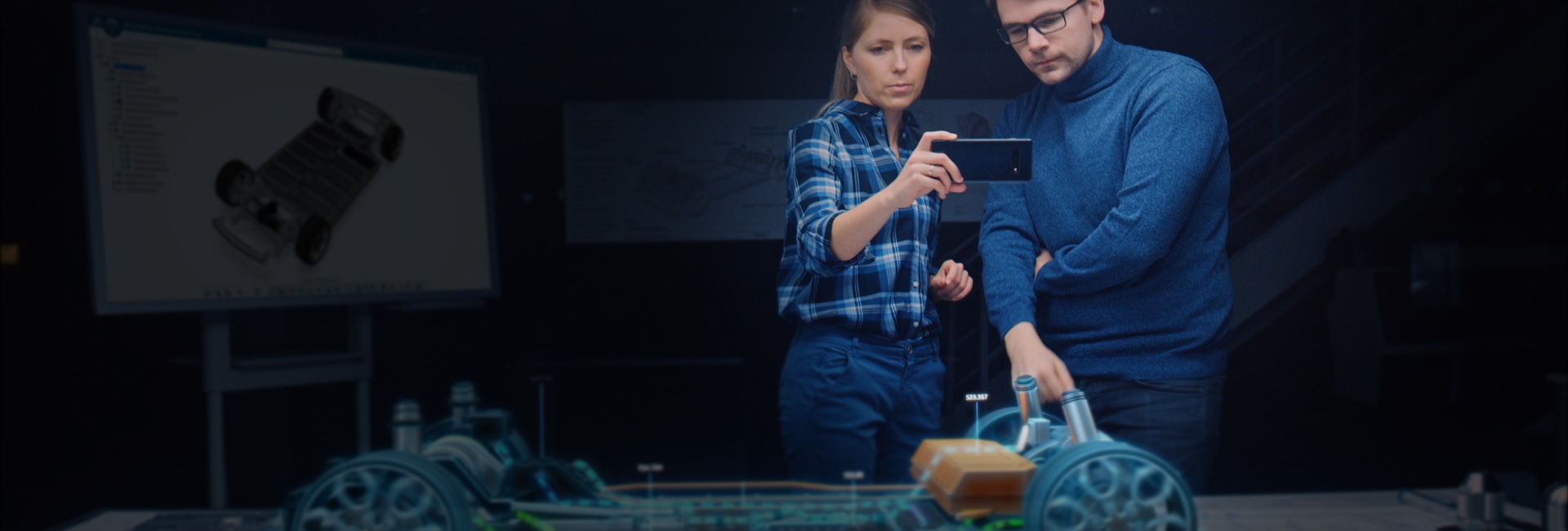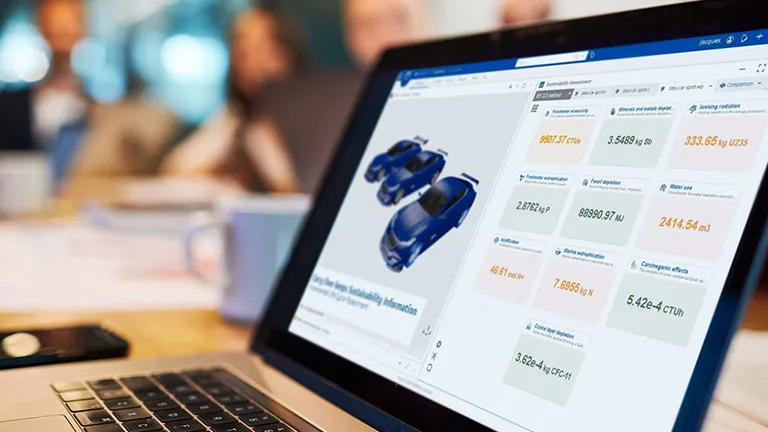Decarbonize Automotive Electrification and Manufacturing
Automotive manufacturers need to connect a complex ecosystem from end to end in one collaborative environment to decarbonize mobility.
Sustainable Mobility
Twenty-three million electric cars are targeted to be sold globally in 2030, leading to 5,750,000 tons (1) of retired batteries by 2040. With the climate change agenda taking center stage globally, automotive and battery producers are under pressure to transform what and how they produce.
How can manufacturers drive a carbon-free future for mobility within a complex and siloed ecosystem? It’s possible with an integrated platform that provides digital continuity to lower the end-to-end carbon footprint of electric vehicles (EVs) by 2050, in line with global net zero initiatives.
Get on the Right Track to Destination Net Zero
Read our ebook and learn how automotive manufacturers can bring ecosystem participants together to reduce carbon emissions in automotive, transportation and mobility.
Forge Ahead With More Innovative Routes
To deliver EVs with a lower carbon footprint, automobile manufacturers need advanced technologies to mitigate carbon-intensive processes and keep costs under control. The answer lies in a cloud-based platform strategy that enables the entire ecosystem to develop and deliver sustainable EVs together. On an integrated digital platform, all stakeholders can work closely and achieve carbon reduction through:
- Optimal electric vehicle designs
- Smart car batteries innovation
- Circular economy practices
Optimal electric vehicle designs
Reducing carbon emissions requires optimal electric vehicle design. Manufacturers can integrate modeling and simulation technologies to create a vehicle’s virtual twin by digitalizing product development. Analyzing a virtual twin's design, behavior and manufacturability will help manufacturers design vehicles that are recyclable, reusable or remanufacturable and can be easily disassembled at end of life.
Smart battery innovation
A smaller carbon footprint calls for lithium-ion batteries that last longer and preserve their efficiency. Virtual testing speeds up innovation to increase battery density for longer electric vehicle lifetimes and fewer replacements. At the same time, higher charging and discharging efficiencies will lead to lower energy consumption during the battery's use phase.
Circular economy practices
EV manufacturers need to integrate eco-design into vehicle development processes and weave emissions goals into the entire value network. With full visibility on an integrated platform, they can leverage lifecycle assessment data to quantify the environmental impact of end-to-end business operations, from lithium-mining to delivering finished EVs.
By implementing multiscale and multidisciplinary solutions on a single digital platform, manufacturers are better positioned to reduce the carbon footprint of vehicle electrification across their entire value chain. The stories below highlight significant initiatives by transportation and mobility industry players to incorporate greener processes into their operations.
Advancing Electric Vehicles for a Sustainable Future
Electric vehicles (EVs) are integral to creating a more sustainable and eco-friendly transportation system. By utilizing clean energy for charging, EVs can drastically reduce greenhouse gas emissions and combat climate change. The sustainability of EVs extends beyond just their operation; adopting circular economy practices ensures that EV components, especially lithium-ion batteries, can be recycled, reused, or repurposed, minimizing waste and resource consumption.
Moreover, the shift towards sustainable EV manufacturing focuses on reducing the carbon footprint during production by optimizing processes with digital platforms and virtual twin technology. These technologies enable manufacturers to design more efficient, recyclable vehicles while reducing emissions across the supply chain, further reinforcing the sustainability of electric vehicles.
Benefits of Electric Vehicles on the Environment
Reduced Greenhouse Gas Emissions
EVs produce zero tailpipe emissions, cutting greenhouse gases and reducing air pollution in cities. This improves air quality and supports better public health.
Clean Energy Integration
Powered by renewable energy like solar and wind, EVs further reduce their carbon footprint. Charging EVs with clean energy supports global climate targets.
Circular Economy and Resource Efficiency
EVs contribute to a circular economy by promoting the recycling of key materials, such as lithium-ion batteries. This reduces resource extraction and supports sustainable manufacturing.
Companies Embracing Sustainability

Evoletric
Evoletric is integrating circular economy principles into their products and processes. They are producing low-waste designs, reusing and recycling limited materials and advancing global electrification to reduce carbon emissions.

Texelis
Texelis reduced energy consumption by expanding the life of vehicle subsystems in line with the United Nation’s Sustainable Development Goal 9. In doing so, they are building resilient infrastructure and supporting green industrialization.
The Heart of Decarbonization
As the single source of truth, the 3DEXPERIENCE® platform brings together systems engineering, modeling, simulation and project management tools to support innovative collaboration and streamline all automotive processes on a single cloud-based platform.
With digital continuity, complete visibility and access to advanced platform solutions such as virtual twin technology and lifecycle assessment, automotive players can better understand where they stand, see where innovation can take them and plan how to get there efficiently with a smaller carbon footprint.
According to the Financial Times Focus report:
- 26% of businesses have adopted advanced digital tools to design and build products with lower carbon emissions
- 52% of businesses are in the process of joining the ranks
1 Source: ScienceDirect
Electric Vehicles Environmental Impact
Electric vehicles (EVs) are gaining traction as eco-conscious substitutes for conventional gasoline-driven vehicles. Although EVs hold promise for emission reduction and enhanced air quality, their environmental influence hinges on the electricity supply.
Research into EV lifecycle reveals that their green advantages rely on electric grid efficiency and power sources. Utilizing renewable energy to charge EVs can mitigate their environmental footprint.
FAQ About Clean Energy Vehicles
Related Content
Decarbonization
Decarbonization aims at reducing emissions throughout the product and service’s life cycle and across the full value chain.
Boost Sustainable Mobility in the Automotive Industry
See how the Virtual Twin strategy enables automotive innovators to develop high-performance, zero-emission, recyclable vehicles.
Enabling the low-carbon transition of the Transportation Sector
Reducing carbon emissions is critical to combat climate change, and the integration of low-carbon energy solutions is key to driving sustainability in product development, manufacturing and usage.
Transportation & Mobility
Driving vehicle innovation toward the mobility of the future.



